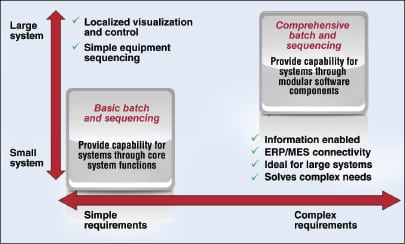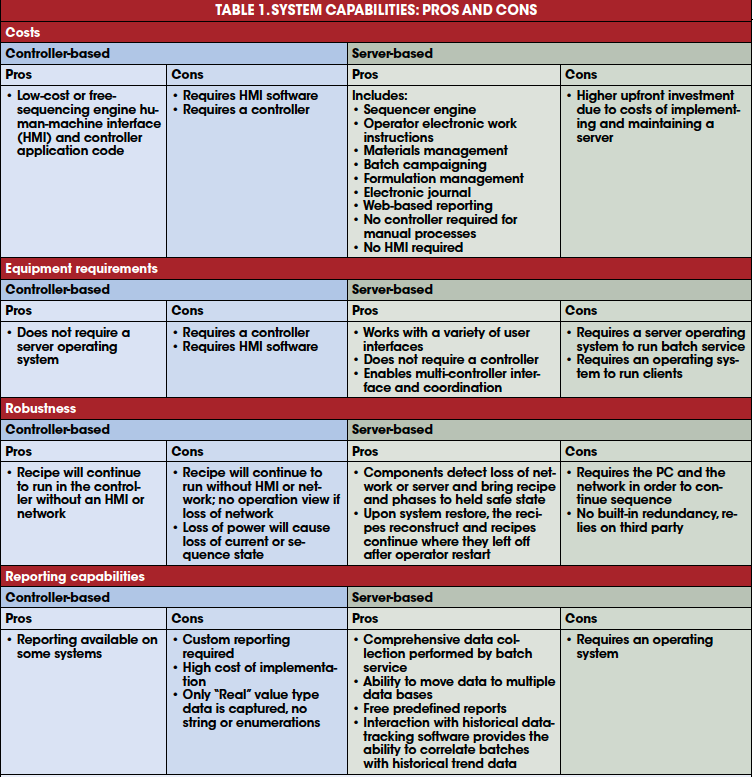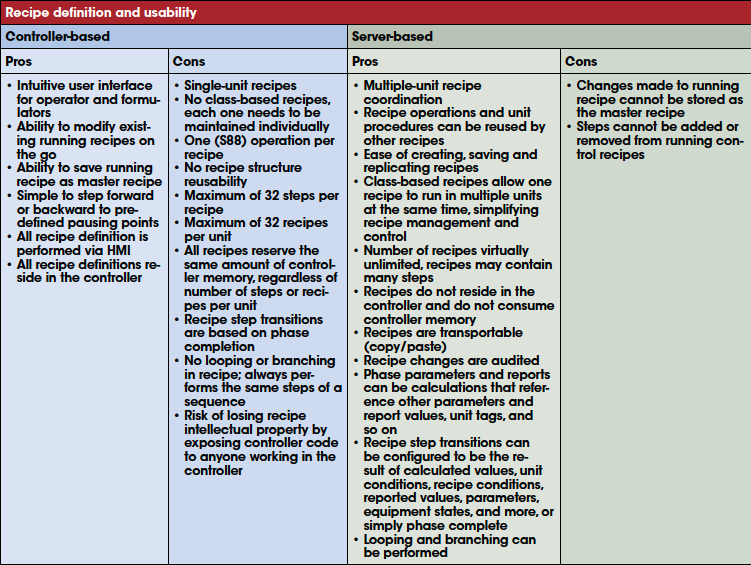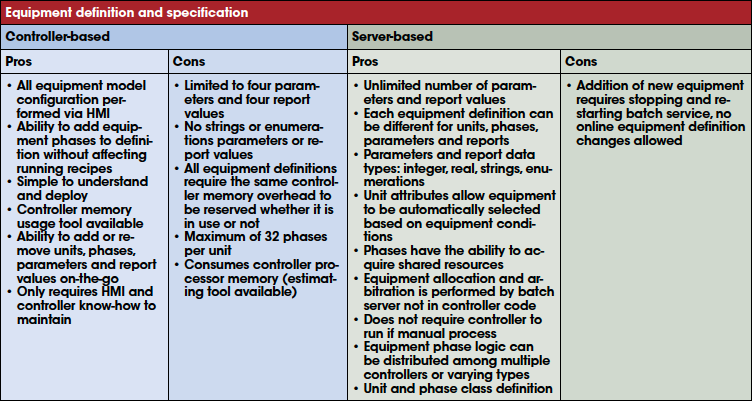When designing a batch system, engineers often select the control solution based on the size of the system. It is traditionally thought that small batch systems require a controller-based sequencing solution, while larger systems require a server-based solution. However, despite traditional practices, the size of the system is not always the best indicator of an appropriate solution. A small application or single-unit system may have complex requirements. For example, it may need to be capable of managing hundreds of recipes or may contain complex decisions or paths based on process conditions.
To identify the right solution, users should consider the three types of batch and sequencing solutions:
• A hard-coded solution — Fixed sequences are programmed as applications in a controller
• A configurable, controller-based solution — Flexible sequences are programmed as applications in a controller
• A server-based solution — An off-the-shelf software product that is specifically designed to solve sequencing requirements, often referred to as a comprehensive solution
Very few systems can leverage custom, hard-coded solutions, as this typically only allows for formula values (setpoints) to be downloaded to a fixed sequence. As a result, when the sequence must change, users are forced to change the code. This adds risk to the process and can add significant costs in terms of design, implementation, testing and validation requirements for the new system.

Due to the rigidity of a hard-coded solution, many engineers prefer to use a configurable, controller-based solution for their small batch needs. This is appropriate if the application requires modular sequence-management capabilities, but the complexity of the process may not be great enough to warrant a server-based software package.
But how does one know if the complexity of the process calls for a controller-based solution? To determine whether or not a given system has simple or complex requirements we must consider the following questions:
1. Does the system have the ability to store the number of recipes required?
2. Does the complete batch occur in a single (S88) unit?
3. Can the system provide the recipe branching and loop backs required?
4. Can the batching system capture and log the amount of data required?
5. Does the system have the ability to specify the type and amount of formula values required?
6. Does the system have enough memory to store the application and number of recipes required?
7. Will the system provide for safekeeping of recipe intellectual properties?
If the answer to all of these questions is yes for a given batch application, then a configurable, controller-based solution may be a suitable choice. The Tables below contain some of factors to be considered during the selection of a controller- or server-based batching solution.



A controller-based solution
Pros: Controller-based solutions typically require no additional upfront licensing investment beyond the human-machine interface and a controller. In addition, a controller-based solution solves simple batching needs; it allows for flexible recipe management and enables local, single-unit supervision and control.
Cons: Limited numbers of recipes, steps per recipe, parameter values and reported values per phase.
This approach typically requires more recipe upkeep in maintaining consistency among similar units.
A server-based solution
Pros:A server-based solution enables maximum flexibility and can be used from simple to the most-demanding batch requirements. Server-based solutions solve higher-level requirements — such as class-based recipes, audit/diagnostics, extensive data collection and reporting, analysis and optimization, equipment arbitration, integration with manufacturing execution (MES) and enterprise resource planning (ERP) systems, manual work instructions, recipe safe-keeping and active material management — all while supporting multi-unit coordination across multiple controllers if required.
Cons: Such systems require the purchase of software silencing.
Case examples
1. Pharmaceutical manufacturer implements new batch and sequence management.AMPAC Fine Chemicals (AFC), one of North America’s largest custom, small-molecule manufacturers of active pharmaceutical ingredients (API), weighed its batch configuration options and migrated its hard-coded control system to a controller-based solution. “AFC really needed a flexible control solution that offered easier system updates to accommodate its highly-varied manufacturing schedule,” said Neal Yates, senior project engineer at Banks Integration, AFC’s long-time automation partner.
“The project was originally scoped only for the control-equipment upgrade so there was no funding available for the addition of batch capabilities,” Yates explained. After considering several alternatives, AFC decided that a controller-based solution would be an ideal alternative to a traditional server-based batch solution.
The controller-based batch and sequencing solution that was selected is independent of application servers and software. As a result, Yates and the Banks Integration Group team were able to deliver a flexible, controller-based solution without the need for costly, engineering-intensive custom code or additional server infrastructure associated with large-scale batch solutions. In addition, the AFC team is now able to configure recipes and formulas directly in the controller using dedicated, user-friendly software that does not require code changes to the system. This important advance helps users streamline the implementation of any approved changes.
With the new system, plant operators at AFC have reduced their use of manual, paper-based batch sheets for detailed processing instructions, thanks to an automated solution embedded directly into the control system. “Many of our production processes require a high level of detail — for example, if we remove a kill solution that deactivates a volatile chemical too soon, it could significantly impact the entire process,” said Mike Ryan, director of Automation Systems and Calibration at AFC. “With the automated batch solution we’re improving the quality and consistency of our APIs, and avoiding the delays that naturally occur during manual operations.”
2. Leading personal-wash company benefits from improved asset and production performance while meeting stringent quality standards.Although a controller-based batch solution was evaluated as an option for AFC, PZ Cussons, a leading personal wash company based in the U.K., had a successful experience implementing a server-based batch solution into its high-speed, liquid-manufacturing process.
As part of a complete overhaul and modernization of its U.K. supply chain, PZ Cussons decided to take advantage of the control and visibility capabilities offered by a modern process-capable automation infrastructure. While establishing the justification for a new U.K. manufacturing facility, the company realized that much of its existing process equipment at its old site was not meeting demands of a modern manufacturing environment.
Starting from a clean slate, PZ Cussons identified many areas where savings could be made and unnecessary costs that could be removed. The company wanted to adopt leaner manufacturing procedures to enable further savings in stock holding and deliveries. The primary challenge was to obtain visibility of all steps in the process and keep all parameters within operational tolerances. This operational goal required extremely accurate batching, mixing and metering systems that could not only communicate with each other, but could also communicate with the master control system within the offices, and within external suppliers, via a secure extranet.
An entirely new processing and production operation was developed. The implementation of the project made full use of the diagnostic data that the fieldbus devices provide. This has given PZ Cussons a level of process visibility and control far beyond what its older plant had. And the new approach is helping the company to attain many of the savings it envisaged, while also removing many of the process variables that had introduced unwanted costs.
PZ Cussons also has effectively been able to simplify some processes that took operators many years to learn. Even then, each operator had his or her own way of doing things on each of the machines, which led to some of the process variability.
With the old approach, all the recipes were hard-coded into the programmable logic controllers so there was no easy way to test new recipes and mixes without a significant recoding exercise. By comparison, the new technology has allowed the company to pilot test new recipes on a small scale prior to mass production. Similarly, using the old approach, there was a need for specialist operators, but due to the scalability and portability of the new software, any operator can now run any line. This allows operators to become multi-skilled — and add value to the areas where their intervention really counts.
Conclusion
The selection of a batch-sequencing system should not only be based on the amount of process equipment, but also on the equipment and procedures level of complexity and the system flexibility.
Author

John Párraga is a product manager at Rockwell Automation (15458 N. 28th Ave., Phoenix, AZ, 85053; Email: [email protected]). He spent his early professional career working on machine design, with an emphasis on rotating machinery, such as turbo chargers for locomotive engines and aircraft engines. For the past 16 years, he has been focused on batch process automation in sectors throughout the chemical process industries (CPI). Párraga holds a B.S. in mechanical engineering from the University of South Florida.